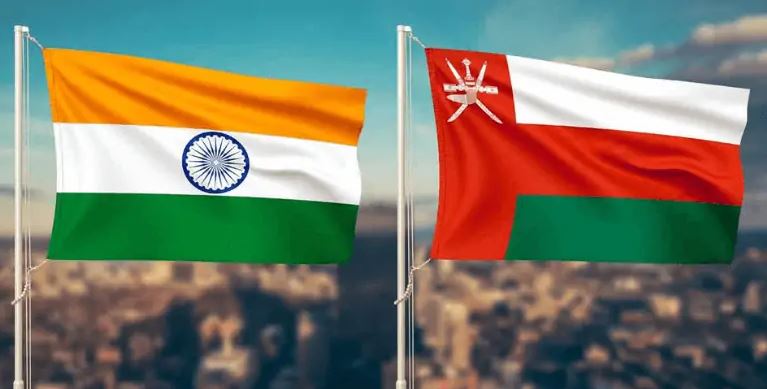New Delhi: Indian goods worth $3.7 billion such as gasoline, iron and steel, electronics, and machinery will get a significant boost in Oman, once both sides reach a comprehensive free trade agreement, a report said Tuesday.
According to the – India-OMAN CEPA: Gateway to Middle Eastern Markets and Beyond – report, prepared by think tank Global trade Reproach Initiative (GTRI), these goods at present face a 5 per cent import duty in Oman.
India and Oman are negotiating a comprehensive economic partnership agreement (CEPA), under which the two countries could significantly reduce or eliminate customs duties on the maximum number of goods traded between them.
Export sectors which could get a boost in Oman include motor gasoline (exports worth $1.7 billion), iron and steel products (exports worth $235 million), electronics ($135 million), machinery ($125 million), textiles ($110 million), plastics ($64 million), boneless meat ($50 million), essential oils ($47 million), and motor cars ($28 million), will benefit from duty elimination, it said.
However, it added that about 16.5 per cent of Indian exports to Oman, worth $800 million and goods that already have duty-free access, will not see additional benefits from the agreement.
These items include wheat ($45 million), basmati rice ($125 million), fruits, vegetables ($76 million), medicines ($76 million), fish ($13.7 million), tea, coffee ($17.7 million).
“The duty elimination will aid most Indian exports, but significant growth in the Omani market, a small, middle-income economy with a $25,000 per capita income, will also depend on product quality improvements,” GTRI Co-Founder Ajay Srivastava said.
He said that India can hope to radically increase its exports post the free trade agreement, as currently over 80 per cent of its goods enter Oman at average 5 per cent import duties, and there are not many trade barriers.
Oman’s import duty ranges from 0 to 100 per cent along with the existence of specific duties. 100 per cent duty is applicable on specific meats, wines, and tobacco products.
India’s merchandise imports from Oman were $7.9 billion in 2022-23. Key imports are petroleum products ($4.6 billion) and urea ($1.2 billion). These account for 73 per cent of imports.
Other key products are propylene and ethylene polymers ($383 million), pet coke ($265 million), gypsum ($115 million), chemicals ($417 million), iron and steel ($62 million), and unwrought aluminium ($95 million).
“These products will gain from FTA-led tariff elimination by India. Most are raw materials and input to industries and India has opened most such imports from other FTA partner countries,” the report said.
Reduction in import duties under the CEPA will allow Indian products to enter the Omani market at competitive prices.
India’ diverse range of products, from pharmaceuticals and textiles to technology and agriculture, will gain a significant advantage, enhancing India’s export potential.
Similarly, Oman’s products, particularly in sectors like oil and gas, petrochemicals, and certain types of manufactured goods, will find a more receptive market in India. Reduced import duties mean these products can be offered at more competitive prices, potentially increasing Omani exports.
On the services side, it said, in 2022, India’s service exports to Oman were worth about $2.8 billion, while its imports were $0.2 billion.
“India could seek increased access to the Omani market for business services and computer and information services, which Oman regularly imports. India might also negotiate for priority visas for its professionals on short-term assignments in Oman. Oman has a weak services sector and may not press for much opening of Indian markets,” Srivastava said.
To provide greater market access for its pharma products, India may request Oman for track approval for Indian pharma products that are already registered with the US Food and Drug Administration (USFDA), UK drug regulator MHRA and European Medicines Agency, it said.
India’s free trade agreement with the UAE has a similar proposal. India has implemented a trade agreement with the UAE in May 2022. Both Oman and UAE are members of the Gulf Cooperation Council (GCC).
India’s GDP of about $3.5 trillion is significantly larger than Oman’s GDP of $115 billion. This indicates that India’s economy is far more extensive and diverse.
With a population of 1.4 billion compared to Oman’s 5 million, India represents a vast consumer market for Oman.
“However, Oman’s higher per capita income ($25,060) compared to India’s ($2,370) could mean a demand for more diversified and possibly higher-value goods and services in Oman, which India could aim to supply,” Srivastava said, adding Oman might use this FTA to diversify its economy, reduce dependence on oil and gas sectors, and develop its human resources by gaining access to India’s educational and technological expertise.
“Beyond the immediate economic benefits, the CEPA holds considerable strategic importance for India. It serves as a gateway for India to strengthen its footprint in Middle Eastern economies. This partnership with Oman can act as a catalyst, enhancing India’s geopolitical presence and fostering deeper ties with other Middle Eastern countries,” he added.
Commenting on the proposed pact, international trade expert and Hi-Tech Gears Chairman Deep Kapuria said this would further help India in consolidating its market access not only in Oman but enable Indian companies to access the wider Middle East region.
“Oman is a growing market for export of refined petroleum, automobile and other manufactured products,” he said.
Kapuria added that over the last two to three years, India’s exports to Oman has increased but import too has significantly gone up resulting in a trade deficit of close to $3.5billion in 2022-23.
“A comprehensive FTA with Oman would not only help India to bridge this deficit but also provide opportunities to increase services exports and open up investment opportunities for Indian companies,” he said.
PTI
